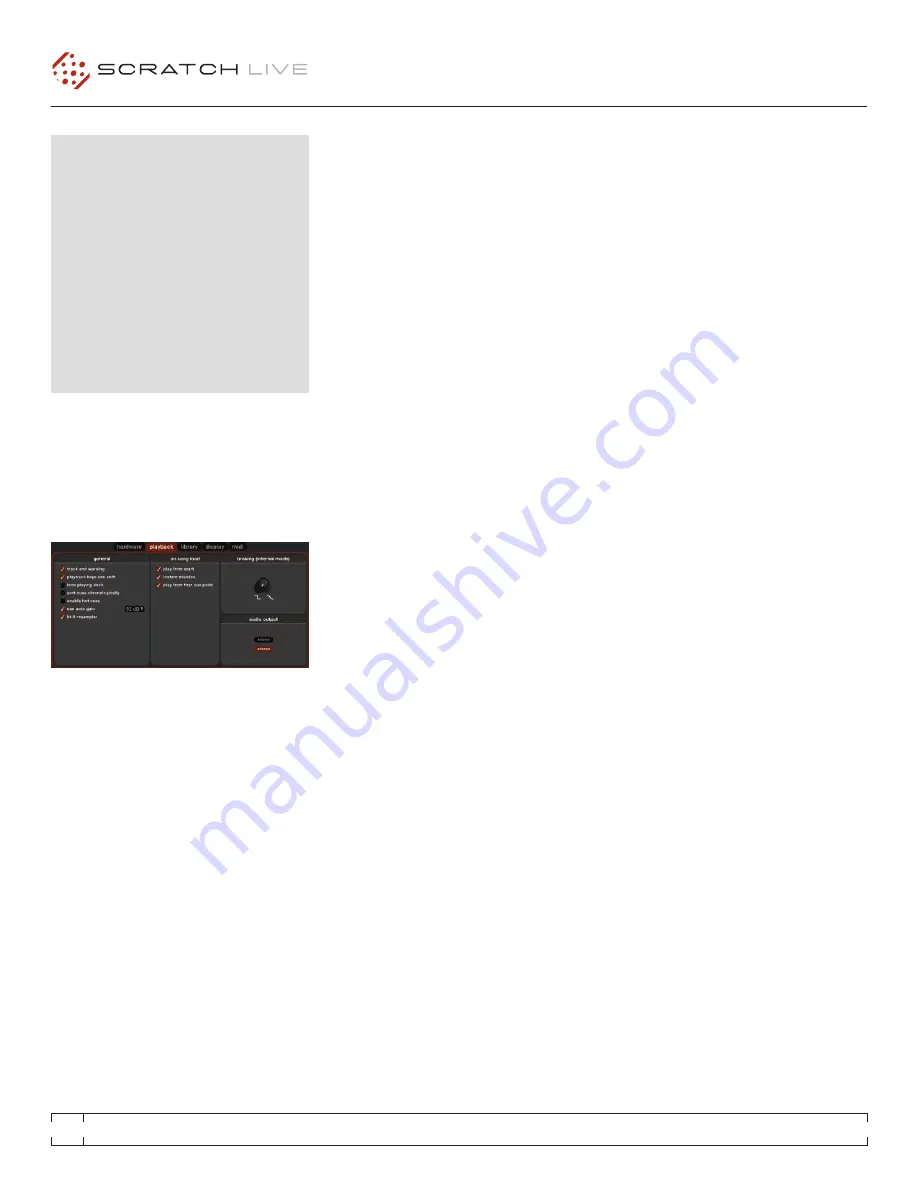
RANE MP 4
FOR
SERATO SCRATCH LIVE
•
OPERATOR’S MANUAL
1.9.2
26
addItIOnaL Setup
This section covers general preferences and
adjustments you can make to improve the
performance of Scratch Live. From the main
screen, click on setup to get to this area.
pLayBacK
tRacK end WaRnInG
Enable track end warning to flash the Virtual
Deck as you approach the end of the track. The
label will start flashing 20 seconds from the end
of the record. The track end warning does not
apply to any tracks under 1 minute long.
pLayBacK KeyS uSe ShIFt
This is checked by default. Unchecking this
option will enable all of these keys without
pressing shift or having caps lock on. This
applies to all cue points (1...0) and cue controls
(QWERTY etc).
See “KeyBOaRd ShORtcutS”
On paGe 25.
LOcK pLayInG decK
Every DJ’s nightmare used to be lifting the needle
off the wrong turntable in the middle of a set.
This setting helps to avoid the digital equivalent;
loading a new track to the wrong deck. When
this option is checked, you can only load a track
if the target deck is stopped.
SORt cueS chROnOLOGIcaLLy
The five cue points can be placed in any order,
and can be dragged up and down if you wish
to reorder them. If you prefer to lock them to
chronological order, turn this option on.
enaBLe hOt cueS
When hot cues are enabled, you can set cue
points simply by pressing the number keys 1
through 0 (no ctrl modifier required). Note that
you can only add cues this way if the cue point
slots are empty.
See “cue pOIntS” On paGe 16.
uSe autO GaIn
Auto gain enables you to set a uniform volume
level for the tracks in your library. When a track is
in auto gain mode, the track gain knob appears
depressed.
To enable auto gain, check the “use auto
gain” box under the playback tab. Provided you
have analyzed your files, your tracks will now be
loaded with the auto gain applied.
Next to the “use auto gain” check box is a
drop down menu, in which you set the target
gain volume level.
To find the optimum setting, load a track with
an average volume level onto one of the Virtual
Decks. Now play the track, and take note of the
volume and LED lights inside the software.
The idea is for the track volume to be sitting
just under the clipping point (indicated by the
LED meter red-lining). If the track is too quiet,
unload it, then go to the playback setup screen
and boost the auto gain dB value more.
Once you’ve made this adjustment, load the
same track onto the Virtual Deck again. You’ll
notice that the volume knob has automatically
adjusted itself.
Keep making adjustments on the same track
until it’s just below the clipping point. Once this
is set you won’t need to adjust the target gain
level ever again.
Because the track you used had an average
volume level, most of the other tracks in your
library should be around the same volume. You
may still need to make minor adjustments to
some individual tracks, but once that’s done
these will stay saved in the ID3 tag of the file.
tIp: Slightly too quiet is always better than
too loud. If your Led meter is in the red, it is
likely that it is clipping. not only does clipping
not sound very nice, it can damage your
equipment.
nOte: your overviews need to be built by
version 1.7.2 or later for auto gain to work.
hI-FI ReSampLeR
This significantly reduces digital distortion at very
slow or very fast record speeds, increasing the
CPU load slightly. This option is off by default,
the old resampler is used when switched off.
pLay FROm StaRt
If this setting is not enabled, freshly loaded
tracks will continue to play from the point the last
track was at. This option is on by default.
InStant dOuBLeS
This allows you to quickly match the playhead
position of two tracks. With this option set, when
you load a track on one Virtual Deck that is
already loaded on the other Virtual Deck (it must
be the same file), the playhead will jump to the
position of the track that was loaded first, with
the keylock state and looping settings copied.
This setting overrides the play from start and
play from first cue point options.
pLay FROm FIRSt cue pOInt
Enable this option to start all tracks from the first
cue point. This setting overrides the play from
start option.
BRaKInG
This controls how fast the deck stops when
play is stopped. Counter-clockwise, the stop
is immediate. Clockwise rotation increases the
stop from a finger grab all the way to a slow
turntable power-down.





















